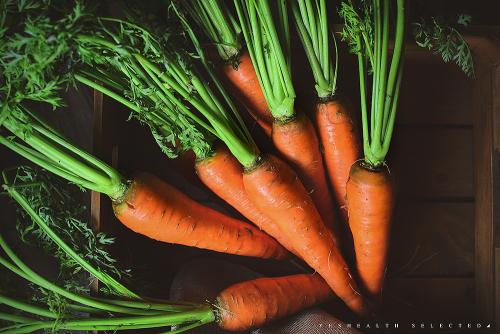Carrot planting method: how to plant carrots? Control methods of carrot pests
Many people like to grow their own carrots because they feel healthier and fresher. And now there are more and more varieties and more choices. And shapes emerge one after another, not only slender, but also spherical, straight bucket, and so on, which may be more popular with children. So how on earth do you plant it? Let's take a look.

Planting:
Carrots and radishes are root-eating crops, so the most important thing is the preparation of the soil. Other plants grow up, these plants grow down, and how long you want your radish to grow, how deep you have to prepare under the soil.
So before planting radish, dig holes to loosen the soil. In addition to removing all the large and small stones, it is also necessary to change the soil as far as possible, with loose soil, including good mixed soil, and then infiltrate some sand before planting. The so-called good soil includes compost soil compost, three-in-one soil Triple Mix and so on.
Any pebble, or a piece of hard soil, will distort your radish.
The average carrot takes 12-16 weeks to grow, so the soil is best prepared before winter or early spring. And then sow the seeds. Because radishes need space to grow down, they should not be planted too closely, otherwise you will spend a lot of time pulling up seedlings in the future. If you want to plant fine radishes, you can plant them a little more closely, otherwise you must leave some room for them to grow. If it is a spherical carrot, the loosening depth of the soil can be shallower, but the distance is greater.
Because the distance of planting radish is very important, we must pay attention to it when sowing. Some people use small forceps to pull out eyebrows. There are also people who buy a large seed, which is called pelleted seeds, but it may not be found, and not all varieties have enlarged seeds.
Roughly speaking, the varieties of early-maturing crops are slender and take 12 weeks to mature, while late-maturing crops are relatively short and take 16 weeks to grow. The ripening time required for each seed package will be stated, from 50 days to more than 100 days. It's usually between 70 and 80 days.
Before planting, you can mix some average fertilizer into the soil, such as 10:10:10, not too much. After that, there is no need to fertilize. But if there is a drought, remember to water . Lack of water will make the radish loose and tasteless. Just like growing tomatoes and cucumbers, you can't cut off the water. If there is a drought and a lot of watering at the same time, it will cause the carrots to break.
Radishes like cooler weather. In the north, they can be planted as soon as they are warm in early spring. (they can be sown two or three weeks before the frost-free period.) In the tropics, it is best to grow in autumn and winter. If you need a long-term harvest, you can plant a batch every two or three weeks. The last batch must be sown 60-70 days before the frost.
Raise the flower bed and barrel planting:
Because growing radish has a special need for soil, many people use raised flower beds to grow, that is, raised bed, for example, uses a board one foot wide to surround an area, which is filled with soil in the middle and then planted on it. In this way, the effort of digging and changing soil is avoided.
Of course, before raising the flower bed, you should also loosen the original soil a little bit, so as not to make the two soils completely different. And it helps smooth drainage. Another way is to use large pots, as long as they are more than a foot deep, or buckets can be planted. But the drainage hole at the bottom of the basin must be big enough and the drainage must be good.
In the past, some people asked how to grow baby carrots, in addition to buying seeds of smaller varieties (including Early crop, which can be planted at a smaller interval, one plant every other inch, and an early harvest at the same time. This kind of soil does not need to be very deep, and it can even be potted.
Pests:
Carrots are more likely to give birth to a small fly, generally called Carrot Fly (Carrot Rust Fly). Most of the flies are attracted by the smell of crushed carrot leaves. So avoid pinching leaves no matter when pulling seedlings or harvesting. Also avoid doing these things when it's windy. The larvae of the bug will go deep into the ground and draw marks on the surface of the carrots, which is very unappetizing.
In order to control weeds, and to maintain soil temperature and water conservation, fertilizer can be added to the soil surface after the root begins to grow, generally good soil can. And pull up the weeds when you see them.
- Prev

Passion fruit cultivation techniques: outdoor Passion fruit overwintering and low temperature cultivation affect production
Do you like passion fruit? Do you want to know something about cultivation techniques? Let's take a look. Passion fruit, sour and sweet, with unique flavor, is loved by consumers at home and abroad. Whether fresh food, juice, or even vegetables are very suitable. Taiwan
- Next

Where is the most authentic origin of red kiwifruit? Red kiwifruit is suitable for growing there.
Do you like red walnuts? Then you want to know where the heart walnut is the most authentic and where it comes from. What kind of place is it suitable for planting? The main producing areas of Hongxin kiwifruit are Dujiangyan in Sichuan, Shangyu in Zhejiang, Liupanshui in Guizhou, Xixia in Henan and so on.
Related
- Fuxing push coffee new agricultural production and marketing class: lack of small-scale processing plants
- Jujube rice field leisure farm deep ploughing Yilan for five years to create a space for organic food and play
- Nongyu Farm-A trial of organic papaya for brave women with advanced technology
- Four points for attention in the prevention and control of diseases and insect pests of edible fungi
- How to add nutrient solution to Edible Fungi
- Is there any good way to control edible fungus mites?
- Open Inoculation Technology of Edible Fungi
- Is there any clever way to use fertilizer for edible fungus in winter?
- What agents are used to kill the pathogens of edible fungi in the mushroom shed?
- Rapid drying of Edible Fungi

